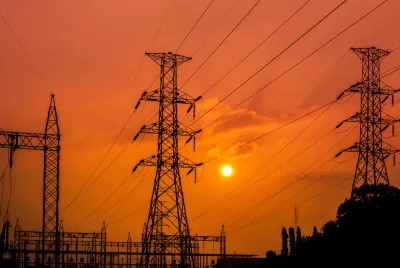The California power grid withstood its biggest test ever on Tuesday and passed—barely. The only rolling blackouts that occurred during the Stage Three Energy Emergency alert were results of miscommunication.

“For nearly three hours Tuesday night, California officials warned of imminent rolling blackouts as the state’s electrical grid struggled to keep up with surging demand during a punishing heat wave,” wrote Grace Toohey, Harriet Ryan, Alexandra E. Petri, and Gregory Yee for the Los Angeles Times at 10:25 PM (PST) on September 6.
Shortly after 7 p.m., the California Independent System Operator (Cal ISO) noted that peak grid demand had hit 52,061 megawatts, “a new all-time record.”
At 8 p.m., Cal ISO downgraded its level 3 alert, the final step before calling for rolling blackouts, saying that “consumer conservation played a big part in protecting electric grid reliability.”
All three levels of Energy Emergency Alert notification, as well as the ’Flex Alert’ and other emergency terms are described by Cal ISO in this 1-page fact sheet [pdf].
ISO Better Prepared
California had last used rolling blackouts in August 2020. This time, the state's grid operator was more prepared, having more battery storage and, to the chagrin of many in the environmental community, four new “temporary emergency power generators,” as described by the California Department of Water Resources, that were activated for the first time on Tuesday.
The temporary emergency power generators are powered by natural gas and are equipped with Selective Catalytic Reduction (SCR) systems to reduce emissions and limit air quality impacts. The program is designed to support a transition to a clean energy future and is temporary in nature.
“The state also has provided incentives to dramatically boost industrial battery storage — which captures electricity from large solar farms during the day and releases it early in the evening when solar power drops because the sun has gone down, but hot temperatures keep air conditioning demand high," reported Paul Rogers for The Mercury News on September 7.
Such battery storage provided about 3,500 megawatts Tuesday and Wednesday, 10 times as much as two years ago.
Most Effective Measure
But Rogers indicated that what may have been the most critical technology to avoid power outages was not energy-related but one of communication.
At 5:45 p.m. the California Office of Emergency Service sent an emergency bulletin that popped onto the cell phones of 27 million people in 25 counties with the largest populations and highest temperatures.
“Conserve energy now to protect public health and safety,” read the alert in English and Spanish. “Extreme heat is straining the state energy grid. Power interruptions may occur unless you take action. Turn off or reduce nonessential power if health allows, now until 9 p.m.”
Over the next 45 minutes, as homeowners turned off lights and eased off air conditioning, electricity demand fell by 2,600 megawatts, more power than the Diablo Canyon nuclear power plant was generating at full capacity, and enough electricity to power 2 million homes.
“Within moments we saw a significant amount of load reduction,” said Elliot Mainzer, CEO of the California Independent System Operator [on Wednesday]. “That significant response allowed us to restore our operating reserves and took us back from the edge.”
Worse Than a Rotating Power Outage
As disruptive as rolling blackouts may be, what is far worse is what happens if the grid operator doesn't order these temporary outages, as described by the Cal ISO fact sheet [pdf] on this tool.
What would happen if the ISO didn’t call for rotating power outages?
By shutting off power in a controlled and planned manner, the ISO can prevent uncontrolled events, such as cascading blackouts or unexpected outages that can sweep into neighboring grids and shut down power to the entire western states region. Those types of widespread outages have the potential to be much more devastating to the grid, cause far more public hardship, and can take days or weeks to restore.
False Alarms
Unfortunately, Cal ISO did not communicate as effectively with three Bay Area cities that operate their own electric utilities: Alameda, Healdsburg and Palo Alto, all members of the Northern California Power Agency, a not-for-profit joint powers authority composed of 16 members supplying electricity to more than 700,000 Californians as well as Bay Area Rapid Transit (BART) riders. The three cities experienced limited outages on Tuesday night, intentionally but unnecessarily.
“Those outages were not ordered by the grid operator, California ISO CEO Elliot Mainzer said Wednesday on a media call,” reported Jessica Flores and Claire Hao for the San Francisco Chronicle on September 7. “He said the NCPA member outages resulted from confusion and misunderstanding.”
“These are situations that obviously happened very infrequently, and there was a lot happening on the grid for everybody last night. So, we’ll double down on the communication to make sure that doesn’t happen again,” Mainzer said.
Public Safety Power Shutoff
Public safety power shutoffs (PSPS) are similar to rotating power outages in the sense that they are intentional but done for a different reason.
“To reduce wildfire risk, California’s utilities may need to proactively turn off power, or 'de-energize,' electrical lines during extreme weather conditions,” states a 1-page fact sheet [pdf] from Cal ISO.
Under the utilities’ Public Safety Power Shutoff (PSPS) program, the state’s largest investor-owned utilities -- PG&E, SCE, and SDG&E – monitor their territories for weather and environmental factors that contribute to wildfires. If the risk of fire is high, the utilities may decide to turn off power on electrical lines to prevent causing a fire to ignite.
Portland General Electric in Oregon “has announced estimated times of Public Safety Power Shutoffs to roughly 30,000 customers,” reported Fox 12 Oregon. “The shutoffs will happen across 10 designated PSPS areas [listed in the article] and two additional areas with high fire risk, PGE said Thursday night.”
Other Power Outages
Of course, outages happen for many reasons, just ask Palo Alto residents. Monday night's outage was caused by a bad transformer and cable; on Tuesday the Cal ISO miscommunication was to blame, and on Wednesday, a squirrel was the cause, reported the Palo Alto Weekly on September 7.
More on Power Outages on Planetizen:
- California-Style Rolling Blackouts Come to Texas, February 18, 2021
- Massive Power Outages in Northern California as PG&E Avoids Wildfire Risk, October 9, 2019
- Five posts tagged 'Power Outage': 2012-2017
- Regulators Push New Tools for Preventing Massive Blackouts, August 2, 2013
FULL STORY: California averts widespread rolling blackouts as energy demands ease amid heat wave

Planetizen Federal Action Tracker
A weekly monitor of how Trump’s orders and actions are impacting planners and planning in America.

Chicago’s Ghost Rails
Just beneath the surface of the modern city lie the remnants of its expansive early 20th-century streetcar system.

San Antonio and Austin are Fusing Into one Massive Megaregion
The region spanning the two central Texas cities is growing fast, posing challenges for local infrastructure and water supplies.

Since Zion's Shuttles Went Electric “The Smog is Gone”
Visitors to Zion National Park can enjoy the canyon via the nation’s first fully electric park shuttle system.

Trump Distributing DOT Safety Funds at 1/10 Rate of Biden
Funds for Safe Streets and other transportation safety and equity programs are being held up by administrative reviews and conflicts with the Trump administration’s priorities.

German Cities Subsidize Taxis for Women Amid Wave of Violence
Free or low-cost taxi rides can help women navigate cities more safely, but critics say the programs don't address the root causes of violence against women.
Urban Design for Planners 1: Software Tools
This six-course series explores essential urban design concepts using open source software and equips planners with the tools they need to participate fully in the urban design process.
Planning for Universal Design
Learn the tools for implementing Universal Design in planning regulations.
planning NEXT
Appalachian Highlands Housing Partners
Mpact (founded as Rail~Volution)
City of Camden Redevelopment Agency
City of Astoria
City of Portland
City of Laramie





























